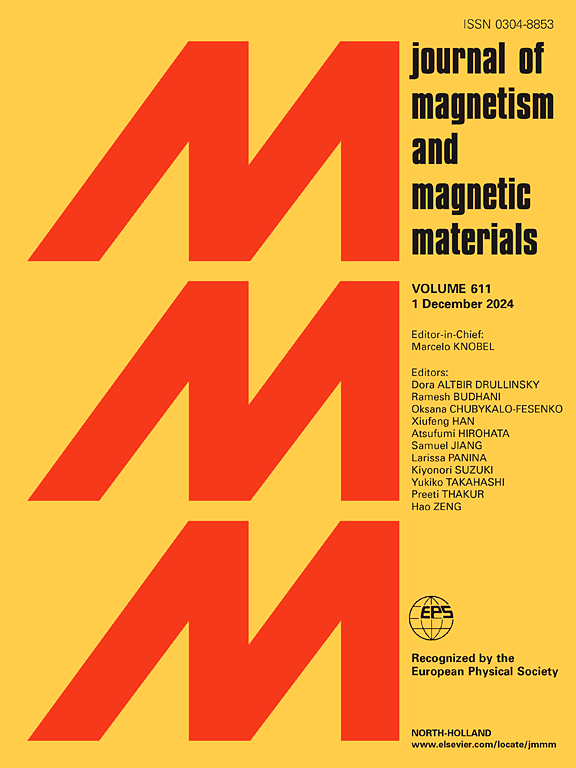cr掺杂Sb2Te3的多功能特性:光电、磁、热电和机械特性的综合研究
IF 2.5
3区 材料科学
Q3 MATERIALS SCIENCE, MULTIDISCIPLINARY
引用次数: 0
摘要
对多功能材料的探索对于能量转换、光电子学和自旋电子学的下一代技术至关重要。碲化锑(Sb2Te3)以其卓越的热电、光学和拓扑特性而脱颖而出,但面临着中等热电效率和高导热性等限制。本研究利用DFT + U计算研究了铬(Cr)掺杂对Sb2Te3的光电、磁、热电和力学性能的影响。铬的掺入显著改变了电子结构,导致带隙缩小和明显的自旋分裂。由此产生的与自旋相关的能带位移增强了电导率,同时保持了相当大的塞贝克系数。DOS分析显示,在费米能级附近的Cr-d态增加了载流子浓度和自旋极化。磁性分析表明,Cr的大磁矩(3.77053 μB)驱动铁磁有序,总磁矩为4.00016 μB,突出了自旋电子器件和量子反常霍尔效应(QAHE)量子计算的潜力。热电评估表明,由于声子散射增强了电导率和降低了晶格导热性,ZT值得到了改善。塞贝克系数在不同温度下仍然是有利的,与自旋相关的变化表明在自旋热电子中的应用。力学性能评价表明,Cr的掺入增强了Sb2Te3的结构稳定性和机械鲁棒性。弹性常数(C11, C33)在掺杂后增加,反映了抗单轴变形能力的提高。增加的剪切常数(C44, C66)表明更强的抗剪能力,而体积模量(40.2 GPa),剪切模量(25.6 GPa)和杨氏模量(64.8 GPa)证实了刚度的增加。泊松比(0.28)表明掺杂材料在实际应用中保持了足够的延展性,而维氏硬度(2.9 GPa)的提高表明材料具有更好的耐磨性。这些机械上的改进确保了材料对承受机械应力的器件的适用性。在光学上,Cr掺杂增加了可见光和红外区的吸收,使该材料适用于太阳能电池、红外探测器和光子器件。改进的介电和能量损失函数反映了改进的光-物质相互作用和降低的反射率。总体而言,cr掺杂的Sb2Te3显示出其多功能特性的协同增强,包括电子,磁性,热电,机械和光学特性。这些全面的改进使其成为自旋电子学、热电发电机和光电子技术的有力候选,为未来的实验验证和设备集成奠定了基础。本文章由计算机程序翻译,如有差异,请以英文原文为准。
Multifunctional properties of Cr-doped Sb2Te3: A comprehensive investigation into optoelectronic, magnetic, thermoelectric, and mechanical characteristics
The quest for multifunctional materials is vital for next-generation technologies in energy conversion, optoelectronics, and spintronics. Antimony telluride (Sb2Te3) stands out for its remarkable thermoelectric, optical, and topological properties but faces limitations like moderate thermoelectric efficiency and high thermal conductivity. This study investigates the impact of chromium (Cr) doping on Sb2Te3’s optoelectronic, magnetic, thermoelectric, and mechanical properties using DFT + U calculations. Cr incorporation significantly alters the electronic structure, inducing bandgap narrowing and pronounced spin splitting. The resulting spin-dependent band shifts enhance electrical conductivity while preserving a substantial Seebeck coefficient. DOS analyses reveal localized Cr-d states near the Fermi level, increasing carrier concentration and spin polarization. Magnetic analyses show that Cr’s large magnetic moment (3.77053 μB) drives ferromagnetic ordering, with a total moment of 4.00016 μB, highlighting potential for spintronic devices and quantum computing via the quantum anomalous Hall effect (QAHE). Thermoelectric evaluations demonstrate improved ZT values due to enhanced electrical conductivity and reduced lattice thermal conductivity from phonon scattering. The Seebeck coefficient remains favorable across temperatures, with spin-dependent variations suggesting applications in spin-caloritronics. Mechanical assessments reveal that Cr doping enhances Sb2Te3’s structural stability and mechanical robustness. Elastic constants (C11, C33) increase upon doping, reflecting improved resistance to uniaxial deformation. Enhanced shear constants (C44, C66) indicate better shear resistance, while bulk modulus (40.2 GPa), shear modulus (25.6 GPa), and Young’s modulus (64.8 GPa) confirm increased stiffness. The Poisson’s ratio (0.28) suggests that the doped material retains sufficient ductility for practical applications, and the improved Vickers hardness (2.9 GPa) signifies better wear resistance. These mechanical improvements ensure the material’s suitability for devices subjected to mechanical stress. Optically, Cr doping increases absorption in the visible and infrared regions, making the material suitable for solar cells, infrared detectors, and photonic devices. Modified dielectric and energy loss functions reflect improved light-matter interactions and reduced reflectivity. Overall, Cr-doped Sb2Te3 exhibits a synergistic enhancement of its multifunctional properties, including electronic, magnetic, thermoelectric, mechanical, and optical characteristics. These comprehensive improvements position it as a strong candidate for spintronics, thermoelectric generators, and optoelectronic technologies, laying the groundwork for future experimental validation and device integration.
求助全文
通过发布文献求助,成功后即可免费获取论文全文。
去求助
来源期刊

Journal of Magnetism and Magnetic Materials
物理-材料科学:综合
CiteScore
5.30
自引率
11.10%
发文量
1149
审稿时长
59 days
期刊介绍:
The Journal of Magnetism and Magnetic Materials provides an important forum for the disclosure and discussion of original contributions covering the whole spectrum of topics, from basic magnetism to the technology and applications of magnetic materials. The journal encourages greater interaction between the basic and applied sub-disciplines of magnetism with comprehensive review articles, in addition to full-length contributions. In addition, other categories of contributions are welcome, including Critical Focused issues, Current Perspectives and Outreach to the General Public.
Main Categories:
Full-length articles:
Technically original research documents that report results of value to the communities that comprise the journal audience. The link between chemical, structural and microstructural properties on the one hand and magnetic properties on the other hand are encouraged.
In addition to general topics covering all areas of magnetism and magnetic materials, the full-length articles also include three sub-sections, focusing on Nanomagnetism, Spintronics and Applications.
The sub-section on Nanomagnetism contains articles on magnetic nanoparticles, nanowires, thin films, 2D materials and other nanoscale magnetic materials and their applications.
The sub-section on Spintronics contains articles on magnetoresistance, magnetoimpedance, magneto-optical phenomena, Micro-Electro-Mechanical Systems (MEMS), and other topics related to spin current control and magneto-transport phenomena. The sub-section on Applications display papers that focus on applications of magnetic materials. The applications need to show a connection to magnetism.
Review articles:
Review articles organize, clarify, and summarize existing major works in the areas covered by the Journal and provide comprehensive citations to the full spectrum of relevant literature.
 求助内容:
求助内容: 应助结果提醒方式:
应助结果提醒方式:


